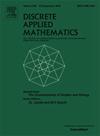关于大半度图中的哈密顿绕道
IF 1
3区 数学
Q3 MATHEMATICS, APPLIED
引用次数: 0
摘要
有向图D中初始顶点优于终端顶点的哈密顿路径称为哈密顿绕道。在任意顶点对之间最多有一条弧的有向图称为有向图(或简称有向图)。设D是一个p阶的最小半度图,其最小半度至少为⌊p/2⌋−1。在本文中,我们证明了如果p≥10且p≠11,则D包含哈密顿绕道。我们所举的几个图的例子表明,这个结果在以下意义上是尖锐的:下界⌊p/2⌋−1和10都是紧的。本文章由计算机程序翻译,如有差异,请以英文原文为准。
On Hamiltonian bypasses in orgraphs with large semi-degrees
A Hamiltonian path in a digraph in which the initial vertex dominates the terminal vertex is called a Hamiltonian bypass. A digraph with at most one arc between any pair of vertices is called an oriented graph (or orgraph, for short). Let be an orgraph of order with minimum semi-degree at least . In this paper, we show that if and , then contains a Hamiltonian bypass. We present examples of orgraphs which shows that this result is sharp in the following sense: both lower bounds and 10 are tight.
求助全文
通过发布文献求助,成功后即可免费获取论文全文。
去求助
来源期刊

Discrete Applied Mathematics
数学-应用数学
CiteScore
2.30
自引率
9.10%
发文量
422
审稿时长
4.5 months
期刊介绍:
The aim of Discrete Applied Mathematics is to bring together research papers in different areas of algorithmic and applicable discrete mathematics as well as applications of combinatorial mathematics to informatics and various areas of science and technology. Contributions presented to the journal can be research papers, short notes, surveys, and possibly research problems. The "Communications" section will be devoted to the fastest possible publication of recent research results that are checked and recommended for publication by a member of the Editorial Board. The journal will also publish a limited number of book announcements as well as proceedings of conferences. These proceedings will be fully refereed and adhere to the normal standards of the journal.
Potential authors are advised to view the journal and the open calls-for-papers of special issues before submitting their manuscripts. Only high-quality, original work that is within the scope of the journal or the targeted special issue will be considered.
 求助内容:
求助内容: 应助结果提醒方式:
应助结果提醒方式:


